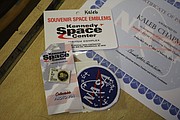Superior students get 'spaced-out' with NASA project
The Superior team didn’t actually take a trip to outer space, but they did team up with NASA to get a glimpse into their operation and speak to real astronauts.
“It was super cool,” said Superior eighth-grader, Eric Vantassel, after receiving his NASA badge and certificate at a recent after school party. Vantassel said he is interest in working for NASA and enjoyed the opportunity to work with this project.
The project is part of the U.S. Department of Education’s ongoing effort to solve a national problem the critical shortage of students with mastery of science, technology, engineering and math (STEM) skills. Through an exciting out-of-school collaboration between the Department and NASA, students from Alberton and Superior conducted scientific experiments and learned the relevance of STEM skills to daily life.
Alberton and Superior schools are part of the Department’s 21st Century Community Learning Centers (21st CCLC) program, which focuses in part on exposing students in high-need schools to meaningful STEM learning opportunities. One goal of the 21st CCLC program, which served more than 1.5 million students in all 50 states in 2016, is to demonstrate the value of STEM skills both inside and outside the classroom, thereby raising student interest in STEM and related professions.
Since NASA first became a partner in 2013, available programs have grown from 20 sites in three states to nearly 146 sites across 15 states in 2016. This year, NASA offered two options for unique STEM experiences: Engineering Design Challenges (EDC) and a Global Observation to Benefit Environment (GLOBE) investigation.
EDC introduces students to the engineering design process so they can develop solutions to real NASA challenges, such as designing a crew exploration vehicle. GLOBE immerses students in scientific investigation techniques, such as data gathering, to learn how clouds impact the Earth’s climate. In both cases, students work with NASA engineers and scientists to receive feedback on their work, learn about STEM careers and find out what it’s like to work in science and engineering professions.
“We’ve been super honored and excited to work with NASA and the You for Youth program,” said Jessica Maurer, Alberton’s 21st Century Afterschool Program Director who applied for the partnership.
This school year, students from Alberton and Superior participated in the NASA partnership program. They joined nine Montana schools who were a part of the project. At Superior, science teacher, Chris Quinlivan led the teams of fifth and sixth grade students, which included Own Doyle, Wyatt Haworth, Trevor Wolff, Jaden and Isaac Rhodder, Aubrie Constant and Brydon Drey, a third grader. Eighth graders Kitty Schoolcraft, Barbara Mitchell-Garcia, Penny Foley, Eric Vantassel, and Kaleb Chapman also participated.
The Alberton team was led by Sandye Adams, who lives in Alberton and teaches science classes for Excelsior College. A dozen students did two of the projects, designing a parachute for a Mars landing, and creating a pressure suit for astronauts.
Both teams had the opportunity to speak with astronauts through an internet conference, along with other teams including Whitefish, Frenchtown, and Big Sky. The projects started in November and wrapped up in late February.
The Superior team had to redesign their parachute a few times before it was acceptable for the “Parachuting onto Mars” project. Where they had to design and build a drag device to slow a spacecraft entry onto the Martian surface. This meant changing the materials they were using and making other adjustments.
The overall mass could not exceed 50 grams, and they used supplies like straws, bubble wrap, fishing line, and pennies. Once a successful prototype was created, they made a short video about their project. It was submitted for competition where judging will take place later this month. There will also be a presentation by local teams at the University of Montana in Missoula, on April 28.
Some of the younger grades also created parachutes in a more simplistic form. Quinlivan held up a series of balloons held together with yarn, as an example. Though the experiment was not as complex as the older team, it gave them the opportunity to explore the science behind the project. Overall, Quinlivan was very pleased with the project and felt the students really enjoyed it and learned a lot.
To celebrate the completion of their project, the Superior team held a small after school party on March 6 where participating students received a NASA badge, a certificate, and “failure is not an option” pin. The pin is a famous line from the movie “Apollo 13”. Which is “the line that reflects the attitude of mission control” according to NASA Flight Director, Gene Kranz.
The Alberton teams will show their project at an assembly in April, and also plan on attending the event at the University of Montana April 28.





